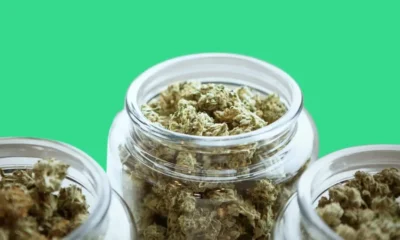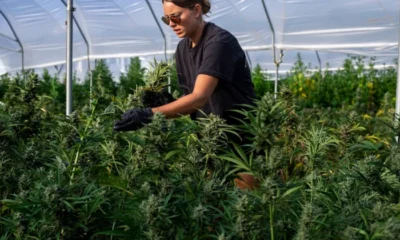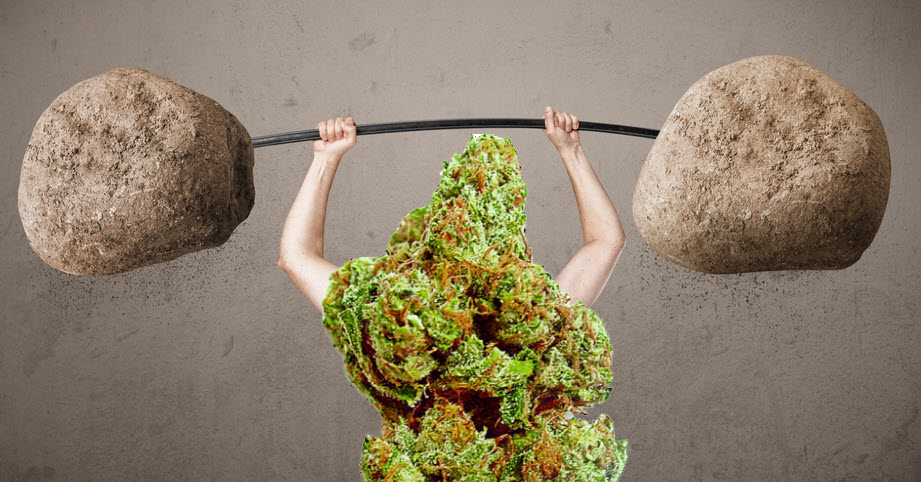Cannabis News
Harnessing the Power of AI to Build Your Digital Cannabis Brand
Published
7 months agoon
By
admin

The world of technology is evolving at an unprecedented pace, and one of the most significant advancements in recent years is the rise of artificial intelligence (AI). Whether we like it or not, AI is here to stay, and it’s transforming industries across the board. As an entrepreneur, you have two options: fight against the tide or embrace the power of AI to propel your business forward.
In this article, we’re going to explore how you can leverage the rising trend of AI to empower your entrepreneurial journey in another thriving industry: cannabis. The cannabis market has been experiencing tremendous growth in recent years, with more and more states and countries legalizing the use of marijuana for medicinal and recreational purposes. This presents a unique opportunity for entrepreneurs to build a strong consumer brand or B2B service in the cannabis space.
While the principles and strategies we’ll discuss can be applied to any niche, we’ve chosen to focus on the cannabis industry to demonstrate how AI can be a game-changer for cannabis consumers looking to transition from being mere consumers to successful producers. By harnessing the power of AI, you can create a digital cannabis brand that stands out in a crowded market and connects with your target audience on a deeper level.
Throughout this article, we’ll walk you through the process of building a cannabis brand using AI in 2024. From developing your brand identity and creating compelling content to optimizing your website and leveraging data analytics, we’ll show you how AI can streamline and enhance every aspect of your brand-building journey.
So, whether you’re a cannabis enthusiast with an entrepreneurial spirit or an established business owner looking to expand into the cannabis market, this article is for you. Get ready to dive in and discover how AI can help you build a thriving digital cannabis brand in the ever-evolving world of technology and cannabis.
Let’s get started!
When it comes to building a successful digital cannabis brand, the first step is to come up with a solid concept. This is where AI can be incredibly valuable. By leveraging the power of Large Language Models (LLMs) like ChatGPT, Claude, and others, you can generate a wealth of ideas and insights to help you identify a profitable niche within the cannabis industry.
To get started, simply prompt the AI to generate a list of potential cannabis-related money-making ideas. Be sure to provide some parameters to ensure that the ideas are feasible and align with your skills, interests, and resources. For example, you might ask the AI to focus on ideas that can be executed with a specific budget, or that cater to a particular target audience.
Once you have a list of potential ideas, take some time to review and evaluate each one. Consider factors such as market demand, competition, and potential profitability. You can even use the AI to help you conduct market research and gather data on each idea to inform your decision-making process.
If you already have a product or service idea in mind, you can skip the ideation step and instead focus on using AI to develop strategies for growing your brand and acquiring customers. For example, you might ask the AI to generate ideas for content marketing, social media campaigns, or email marketing initiatives that are specifically tailored to the cannabis sector.
When using AI to come up with a concept, it’s important to remember that the outputs generated by the model are only as good as the inputs you provide. Be sure to ask clear, specific questions and provide enough context to ensure that the AI can generate relevant and valuable insights.
Ultimately, the key to success in the cannabis industry (or any industry, for that matter) is to identify a unique value proposition and deliver a high-quality product or service that meets the needs of your target audience. By leveraging the power of AI to help you come up with a winning concept, you’ll be well on your way to building a thriving digital cannabis brand in 2024 and beyond.
Now that you have a solid concept for your digital cannabis brand, it’s time to bring that concept to life by creating a strong brand identity. This is where you’ll define the visual and verbal elements that will represent your brand across all touchpoints, from your website and social media profiles to your product packaging and marketing materials.
One of the first steps in building your brand is to establish your online presence. While it may be tempting to jump on every social media platform out there, it’s important to be strategic and focus your efforts on the channels where your target audience is most active. Take some time to research your ideal customer and identify the platforms they use most frequently. Whether it’s Instagram, Twitter, or LinkedIn, choose one primary platform to focus on initially and master it before expanding to others. This will help you avoid spreading yourself too thin and ensure that you’re able to build a strong, engaged community around your brand.
In addition to your social media presence, it’s also recommended to create a self-hosted website and start building an email list. Your website will serve as the central hub for your brand, where customers can learn more about your products or services, make purchases, and connect with your brand on a deeper level. An email list will allow you to stay in touch with your customers and keep them informed about new products, promotions, and other brand updates.
When it comes to creating your visual brand identity, AI image generators like Leonardo.ai, MidJourney, ChatGPT plus, and Canva can be a great starting point. These tools can help you generate ideas for your logo, product packaging, and other visual elements. You can then refine and build out these ideas using photo editing tools like Photopea or Canva to create a cohesive and professional-looking brand identity.
Finally, use language models like ChatGPT to help you craft compelling brand messaging, including your bio, mission statement, vision, and product or service descriptions. While these tools can be incredibly helpful in generating ideas and content, be sure to edit and refine the outputs to ensure that they align with your brand voice and values.
By following these steps and leveraging the power of AI, you can create a strong, memorable brand identity that will help you stand out in the crowded cannabis market and connect with your target audience on a deeper level. Remember to link all of your brand elements together, from your website and social media profiles to your product packaging and marketing materials, to create a cohesive and seamless brand experience for your customers.
Content creation is the lifeblood of any successful digital brand, and this is especially true in the cannabis industry. Fortunately, with the advent of AI technology, creating high-quality, engaging content has never been easier. By leveraging the power of AI, you can save time and resources while still delivering valuable content that resonates with your target audience.
When it comes to written content such as blog posts, landing pages, website copy, and email copy, Large Language Models (LLMs) like Claude and ChatGPT are your best friends. These advanced AI models can generate human-like text based on your prompts and guidelines, allowing you to quickly and easily create compelling content that informs, educates, and engages your audience. As of the writing of this article, Claude is widely regarded as the most advanced and capable LLM, but others like Meta’s LLaMa are also making significant strides.
For visual content, AI-powered image generators like Leonardo and MidJourney are revolutionizing the way brands create graphics and imagery. These tools allow you to generate stunning, high-quality images with just a few prompts and guidelines, saving you countless hours of design work. Even Canva, a popular graphic design platform, now offers AI-powered image generation tools that make it easy to bulk create visual content for your brand.
One thing to keep in mind when using AI-generated visual content is the potential for generic or repetitive designs. While bulk creation can be a great way to save time and streamline your content creation process, it’s important to ensure that your visual content still feels unique and on-brand. This is especially true for content like quotes, tips, and tricks, where the message may be more important than the visual itself.
In addition to content creation, backend automation is another key area where AI can help streamline your business processes. Email marketing software like Zoho Campaigns and Mailchimp offer powerful automation capabilities that can help you nurture your leads and customers, deliver targeted messages, and keep your audience engaged with your brand. However, it’s important to note that some platforms like Mailchimp have strict policies against promoting cannabis-related products or services, so be sure to carefully review each platform’s guidelines before making a decision.
Finally, AI can also be used to create a wide range of marketing materials, including business cards, flyers, virtual flyers, and more. By leveraging AI-powered design tools and templates, you can quickly and easily create professional-looking marketing materials that help you stand out from the competition and attract new customers to your brand.
As we’ve explored throughout this article, the rise of AI technology has opened up a world of possibilities for entrepreneurs looking to build a successful cannabis brand. From concept generation and brand development to content creation and automation, AI is revolutionizing the way businesses operate and grow.
For aspiring cannabis entrepreneurs, there has never been a better time to take the leap and start building your own brand. With the power of AI at your fingertips, you can quickly and easily create high-quality content, develop a strong brand identity, and streamline your business processes – all at a fraction of the cost and effort required just a few years ago.
As AI technology continues to evolve and advance, the possibilities for cannabis entrepreneurs will only continue to grow. With open-source models like Meta’s LLaMa on the horizon, we’re quickly approaching a future where entire “offices” can be contained within a single machine, allowing entrepreneurs to run their businesses with unprecedented efficiency and flexibility.
But perhaps most importantly, the rise of AI is leveling the playing field for entrepreneurs of all backgrounds and experiences. No longer do you need a massive budget or a team of experts to build a successful brand – with the right tools and strategies, anyone can create a thriving cannabis business from the comfort of their own home.
So if you’ve been dreaming of starting your own cannabis brand, now is the time to take action. Embrace the power of AI, stay ahead of the curve, and seize the incredible opportunities that await you in this rapidly evolving industry.
The future of cannabis is bright, and with the help of AI, there’s no limit to what you can achieve. So what are you waiting for? Start building your brand today, and join the ranks of the successful cannabis entrepreneurs who are shaping the industry of tomorrow.
AI AND CANNABIS, READ ON…
You may like
-


Ready For Green And Blackout Wednesday
-


NY’s new ‘luxury’ legal cannabis dispensaries are as bad, in their own way, as the creepy illicit ones
-


10 Best Weed Strains for Beginners
-


6 Eco-Friendly Cannabis Brands Making a Difference in New York
-


Weed joints are hella expensive in this state
-


What Your Method of Cannabis Consumption Says About you
Cannabis News
Republicans May Legalize Cannabis in America, Wait, What?
Published
1 day agoon
November 25, 2024By
admin

Keep on Pushing! I can see a Crack in the Wall…
As I sit here rolling up my morning joint, I can’t help but marvel at how far we’ve come in the cannabis legalization movement. What was once relegated to the shadows of society, demonized by decades of propaganda and prohibition, has emerged into the mainstream with such force that even the most ardent opponents are starting to change their tune.
You know something significant is happening when Republican senators start calling cannabis rescheduling “half-assed measures” and argue for full legalization. The winds of change are blowing, my friends, and they’re carrying the sweet scent of reform with them.
Look around – despite federal prohibition, 38 states have established medical cannabis programs, and nearly half allow adult recreational use. This isn’t just progress; it’s a revolution in slow motion. The dominoes are falling one by one, and the momentum seems unstoppable. Even in states where cannabis remains illegal, there’s growing pressure from constituents who’ve witnessed the sky decidedly not falling in neighboring legal states.
But here’s what really gets me excited: I’m starting to see cracks in the great wall of prohibition. These aren’t just surface fractures – we’re talking about deep, structural weaknesses in the foundation of cannabis prohibition itself. When both Democrats and Republicans start seriously discussing federal reform, albeit from different angles, you know we’re approaching a tipping point.
The time has come to double down on our efforts. Like water wearing away at stone, our persistent push for reform is finally showing results. The barriers that once seemed impenetrable are beginning to crumble, and the path to meaningful change is becoming clearer by the day.
So, let’s dive into what’s really happening in the corridors of power, examine the shifting political landscape, and explore why this might be our moment to push through to victory. The game is changing, folks, and we’re all front-row witnesses to history in the making.
For years, we cannabis advocates have operated under the assumption that Republicans were our sworn enemies in the fight for legalization. And let’s be honest, with dinosaurs like Senator Chuck Grassley still roaming the congressional halls, it’s not an entirely unfair assessment. However, something interesting has been happening over the past few years – support for cannabis reform has quietly been creeping across party lines.
Case in point: Senator Thom Tillis from North Carolina (not exactly a bastion of progressive drug policy) recently dropped a truth bomb that had me nearly dropping my bong in surprise. He called the current attempts at rescheduling cannabis and banking reform “half-measures—we could even argue half-assed measures.” Coming from a Republican senator, those words carry serious weight.
But Tillis didn’t stop there. He went on to argue that we’re “dancing around the issue” and need “one consistent framework” for cannabis regulation, similar to alcohol and tobacco. His vision includes authenticating crops, mandating proper FDA oversight of products, and allowing banking access. Holy smokes, folks – this is exactly what many of us have been preaching for years!
What makes Tillis’s position particularly interesting is how he frames it in terms that appeal to traditional Republican values: proper regulation, captured revenue through excise taxes, and dealing with “negative consequences” through a structured framework rather than prohibition. It’s like he’s reading from the cannabis advocate’s playbook, but translating it into Republican-speak.
And he’s not alone. We’re seeing more Republican lawmakers stepping up to support various aspects of cannabis reform. From Rep. Matt Gaetz’s vocal support for veterans’ access to medical cannabis to former Republican-turned-independent presidential candidate Vivek Ramaswamy’s calls for federal legalization, the tide is definitely turning.
The key here is that Republicans aren’t necessarily opposed to cannabis reform – they just need it packaged in a way that aligns with their political philosophy. Talk about states’ rights, proper regulation, economic opportunities, and tax revenue, and suddenly you’re speaking their language. Throw in some tough standards for quality control and age restrictions, and you’ve got yourself a conservative-friendly cannabis bill.
Is this the crack in the wall we’ve been waiting for? It’s certainly promising. When mainstream Republican senators start calling for comprehensive federal frameworks instead of piecemeal reforms, you know something’s shifting in Washington. But let’s not break out the celebration joints just yet – there’s still plenty of work to be done.
The wall of prohibition may be cracking, but it hasn’t fallen. What we need now is to keep pushing, keep advocating, and keep highlighting how sensible cannabis reform aligns with conservative principles of personal freedom, states’ rights, and regulated markets. The momentum is building, and with more Republicans like Tillis speaking out, that wall might just come tumbling down sooner than we think.
Remember folks, every crack starts small before it brings down the whole damn wall. Keep on pushing!
Have the Democrats turned into the Council of Karens?
Well, well, well… look who’s clutching their pearls over hemp-derived cannabinoids these days. The Democratic majority in the Senate Agriculture Committee just released their version of the Farm Bill, and folks, it reads like it was written by a committee of concerned suburban moms who just discovered their teenagers might be having fun.
Now, don’t get me wrong – there are some positive aspects to their proposals. They’re planning to remove background checks for industrial hemp farmers, which is fantastic. It’s about time we stopped treating hemp farmers like potential drug kingpins for growing what’s essentially an agricultural crop.
But here’s where things get Karen-level dramatic: they’re pushing for a “total THC” testing requirement that would effectively eliminate a whole range of products from the market. Jonathan Miller from the U.S. Hemp Roundtable hit the nail on the head when he said this move is “intended to eliminate a whole range of products” and could potentially “eliminate the whole hemp extract industry.”
Let’s be real here – this isn’t about safety. This is about control. Delta-8 THC and other hemp-derived cannabinoids have been legally available across the country, providing relief and enjoyment to countless adults who live in states where traditional cannabis remains prohibited. Has society collapsed? Have we seen an epidemic of hemp-derived cannabinoid emergencies? Nope and nope.
Instead of embracing the innovation and entrepreneurship that’s flourished under the 2018 Farm Bill, Democrats seem hell-bent on playing helicopter parent to the entire nation. “Oh no, people might be enjoying themselves with legal hemp products! Quick, someone write a regulation!”
The irony here is palpable. The same party that champions personal freedom when it comes to bodily autonomy suddenly transforms into a bunch of finger-wagging nannies when it comes to hemp-derived cannabinoids. They’re essentially trying to kill an entire industry that’s operating legally and serving millions of Americans who choose to use these products.
You have to wonder – is this why Democrats have been losing ground across the country? Have they become so disconnected from their base that they think people want more restrictions on their personal choices? While Republicans are starting to embrace cannabis reform (albeit slowly), Democrats are out here trying to restrict access to legal hemp products.
Look, if you’re worried about product safety, then regulate for safety. Create standards for testing, labeling, and manufacturing. But trying to eliminate an entire category of products because “someone might get high” is peak Karen behavior. “I’d like to speak to the manager of the hemp industry!”
Maybe it’s time for Democrats to step back, take a deep breath, and remember that they’re supposed to be the party of progress, not prohibition. Because right now, they’re starting to sound an awful lot like the Republicans they used to criticize.
Just saying… would you like to speak to my manager about it?
Then there’s RFK
Just when you thought politics couldn’t get any stranger, here comes Robert F. Kennedy Jr. potentially heading up the Department of Health and Human Services under Trump. Talk about a plot twist! And while nothing’s set in stone yet, this potential appointment has got me feeling cautiously optimistic about the future of drug policy reform.
Why? Because RFK Jr. isn’t your typical bureaucrat when it comes to cannabis and psychedelics. He’s openly advocated for making psychedelic drugs available “at least in therapeutic settings and maybe more generally.” That’s not exactly the kind of talk we’re used to hearing from potential HHS heads.
When it comes to cannabis, he’s been even more direct, supporting legalization and taxation, with the proceeds going toward creating “healing centers” for addiction recovery. He’s also backed making banking services available to the cannabis industry. As someone who would oversee agencies like the FDA, his progressive stance on these issues could be a game-changer.
Now, I know what you’re thinking – this is a Trump administration we’re talking about. But here’s where it gets interesting: along with RFK Jr., other Trump nominees like Matt Gaetz and Tulsi Gabbard have also expressed support for drug policy reform. It’s like we’ve stumbled into some bizarre alternate universe where a Republican administration might actually advance drug policy reform more effectively than their Democratic predecessors.
Of course, we need to keep our feet firmly planted in reality here. Nothing’s guaranteed, and campaign promises have a funny way of evaporating once people take office. But the mere possibility that we could see significant drug policy reform under a Republican administration, with RFK Jr. at the helm of HHS, is enough to make my head spin.
For now, we’ll have to wait and see how the political chips fall. But one thing’s for certain – the landscape of drug policy reform is shifting in ways none of us could have predicted. Stay tuned, folks. This could get interesting.
INSPIRATION:
The Crack in the Red Wall:
https://www.marijuanamoment.net/gop-senator-says-marijuana-banking-and-rescheduling
-are-half-assed-measures-arguing-cannabis-should-be-legally-regulated-like-alcohol-and-tobacco/
The Council of Karens
https://www.marijuanamoment.net/senate-democrats-proposed-
changes-to-federal-hemp-laws-could-eliminate-a-whole-range-of-products-industry-advocate-says/
Then there’s Kennedy
https://www.marijuanamoment.net/rfk-jr-could-advance-marijuana-
and-psychedelics-reform-agenda-as-trumps-top-health-official/
REPUBLICANS BLOCKING WEED OR NO? READ ON…
IS THERE A RED WALL IN AMERICA BLOCKING CANNABIS LEGALIZATION?
Cannabis News
A History of Cannabis Use in Different Cultures and Parts of the World
Published
1 day agoon
November 25, 2024By
admin

The discussion surrounding cannabis and its merits has become a global phenomenon. The United States seems a lot more open to the legalization of marijuana, with several states having already decriminalized or outright legalized the practice.
In Europe, the situation is much the same. There are several countries where marijuana is free to use, recreationally or for medical purposes. However, the question we’d like answered is this; for how long have humans been using cannabis, and what were the different reasons?
The Origins of Cannabis
It is difficult to say exactly which regions of the world cannabis is native to. Many scientists, botanists, and historians believe that the plant’s origins can be traced to Central Asia, particularly the regions of Mongolia and Siberia. Archeologists with a particular interest in these regions have discovered some evidence, suggesting that the plant was first cultivated and used over 12,000 years ago.
It is impossible to know what all of the uses for cannabis were during this time. It is only recently that most western nations have legalized the use and growing of cannabis. With modern tools to help home growth, we can start to uncover all of the different uses for the cannabis plant. However, it can be tough to determine what the uses were thousands of years ago.
Still, archeologists have managed to uncover at least some of the different uses. For example, we know that in the Altai Mountains of Central Asia, tribal and nomadic societies used the plant in a mourning ritual. Piles of cannabis would be placed on a grave, and then burned. The smoke might have been seen as the spirit of the departed being released.
Cannabis in Rituals
The use of cannabis in religious or spiritual rituals continued throughout history. Even today, many smokers claim that they’ve experienced “spiritual awakening” while partaking in marijuana usage. Though we know that Central Asian tribes used it in mourning, there is no evidence to suggest that they would inhale the smoke, in an attempt to get to some sort of religious epiphany.
The evidence of that being the case, however, comes from India, where cannabis played a role in a variety of religious rituals and practices. The Atharva Veda, a sacred Hindu text mentions “bhang” (the ancient Indian word for cannabis) as one of the five sacred plants, associated with the Hindu deity Shiva. India is also the first civilization where we can find written evidence of marijuana smoking.
Evidence of cannabis being used in religious or mystical rituals can also be found in the Middle East, during the early years of Islam. Sufi mystics would regularly partake in smoking the plant, called Hashish, which is the origin of the modern slang term “hash.” However, cannabis use in the Middle East was much more widely associated with social pleasantries, which we will get to further in this article.
Cannabis as Medicine
The de-stigmatization of marijuana in the modern world can largely be attributed to the studies proving that the plant can help with certain physical and mental illnesses. Medical marijuana, for example, has shown to have a positive effect on persons suffering from Parkinson’s Disease, different forms of cancer, and mental disorders such as social anxiety, clinical depression, etc.
While many believe that these discoveries are entirely new, the truth is that humans have known about the medicinal power of the plant since the ancient world. In fact, evidence of marijuana being used medicinally comes from China, where it was used to treat different maladies, from joint paint to migraines.
It is worth noting that there is no direct evidence that cannabis was smoked in China. Rather, it was applied as ointment on the skin, or was ingested in the form of tea. The evidence for such uses of the marijuana plant can be found in the ancient Chinese text, Shennong Bencaojing, a medical text dating back to the first and second century.
Even today, marijuana is used frequently in the pharmaceutical and medical industries. Before its legalization, a strain of the plant was used to create creams and ointments, meant to treat joint pain. The strain used for these creams involved the removal of THC, which is the chemical in marijuana that results in a feeling of “high.”
Recreational Cannabis
We hinted before that the first evidence of cannabis being used recreationally comes from India. Not only did the ancient Indians drink cannabis tea, they also smoked the plant in pipes. The truth, however, is that there is no real evidence that they did so recreationally. Perhaps the pipes were used during specific rituals, and the tea was ingested only on certain holidays.
On the other hand, we are quite aware that, during Islam’s early years, Middle Easterners would frequently partake in hashish during social gatherings. The plant would be smoked from а hookah, or a waterpipe. Today, some might draw a parallel between the hookah and the bong, and find that there is quite a bit of a similarity.
Arab traders brought marijuana to Africa and to Europe. In Africa, “dagga” is still being smoked to this day by tribal people medicinally and recreationally. In Europe, marijuana was introduced during the Middle Ages, thanks to trade routes established with the Moors. However, during this time, the plant was not used recreationally.
It wasn’t until the 19th century that the Europeans discovered the recreational use for cannabis, by observing colonized people in North Africa, India, and the Middle East. On the mainland, smoking marijuana quickly became a popular pastime. The famous “Hashish Club” formed in Paris during this time, which saw members like Charles Baudelaire, a famous French poet of the era.
The Prohibition on Cannabis
The early 20th century saw a rise in prohibition movements surrounding both alcohol and marijuana. Of course, we all know how prohibition on alcohol went in the United States. However, the prohibition on marijuana managed to stick, and there are still plenty of countries to this day that ban any and all marijuana use.
However, a recent rise in anti-prohibition movements seems to be quite effective. Three countries in the European Union have legalized cannabis for personal use, and plenty more have decriminalized smoking the plant. We may just see a future where marijuana is free to use worldwide.
THE HISTORY OF THE CANNABIS PLANT, READ ON…
WHO WAS THE FIRST PERSON TO SMOKE WEED IN HISTORY?
Cannabis News
Top 5 Delta 9 Edibles That Actually Work and Taste Delicious
Published
3 days agoon
November 23, 2024By
admin

Delta-9 THC is a powerful cannabinoid that offers a unique blend of relaxation and mental euphoria. Unlike other cannabinoids, Delta-9 provides a calming yet uplifting effect, making it ideal for those seeking stress relief or improved sleep.
The best Delta 9 gummies offer an easy, discreet way to consume this compound without the hassle of smoking or vaping. But with unlimited options on the market, choosing the one that best fits your needs can be hard. That’s why, after analyzing over 1200 customer reviews and 38+ expert recommendations, we’ve selected the top 6 Delta 9 gummy brands. These edibles are known for their potency, quality ingredients, and amazing effects.
Best Delta 9 Gummies in 2025
-
Exhale: Overall Best Brand for Premium Delta 9 THC Gummies
-
Budpop: Most Potent Delta 9 Gummies
-
High Test Gummies: Strawberry Diesel Live Resin Gummies – Hybrid for Energy
-
CBDMd: Delta 9 Gummies for Relaxation and Focus
-
CannaBuddy: Delta 9 Gummies with Various Flavor Options
-
HomeTown Hero: Delta-9 THC Gummies for Sleep
#1. Exhale: Overall Best Brand for Premium Delta 9 THC Gummies

Why Do We Love Them?
Exhale Wellness ranks as the top choice for Delta 9 gummies, offering premium, hemp-derived gummies that meet the 2018 Farm Bill regulations and contain less than 0.3% THC. The brand offers potent and diverse Delta 9 gummy options, including D9 + Caffeine, Live Resin D9, and unique blends with HHC and Amanita. Each gummy comes in various potency levels, combining minor cannabinoids like CBC, CBG, CBN, and CBD to enhance effects.
Customers highly rate Exhale’s gummies for promoting relaxation, pain relief, and restful sleep. Many find them delicious, fast-acting, and powerful, with some reporting a mild “high” within the legal THC limits.
Pros
-
100% organic ingredients
-
$20 off on the first order
-
Third-party lab-tested for purity
-
20+ other Delta 9 THC strains
Cons
Specs
-
Potency Options: Exhale’s Delta 9 gummies contain 100 to 500mg of THC per pack, offering balanced effects for various needs.
-
Packs Available: The brand offers gummies in different pack sizes, from individual to bundles of 2, 3, or 5.
-
Flavors: Exhale’s Delta 9 gummies come in delicious natural fruity flavors, including Apple, Berry, Fruit, Tropical Mix, and Strawberry.
-
Price Range: The small packs of 100mg cost $9.98, while larger extra-strength bottles cost up to $99.95.
#2. Budpop: Most Potent Delta 9 Gummies

Why Do We Love Them?
BudPop is a popular brand known for offering the 18 most potent Delta 9 gummies on the market. With powerful dosages ranging from 8 to 50 mg per gummy, BudPop’s gummies provide strong effects that appeal to new and experienced users. Their noticeable effects are perfect for those seeking relaxation, euphoria, or better sleep.
Available in various fruity flavors, such as Blueberry, Kiwi, Mango, Strawberry, and Watermelon, Budpop’s gummies are praised by customers for their delicious taste and smooth texture. Customers report enjoying the effects for 4-6 hours with these strongest Delta 9 gummies.
Pros
-
Excellent customer service
-
Several payment methods are accepted
-
Small-batch production for freshness
-
Vegan and cruelty-free
Cons
Specs
-
Potency Options: Budpop’s Delta 9 gummies range from 450mg to 1500mg THC per pack, offering a variety of strengths to suit different preferences.
-
Packs Available: The brand offers gummies in different sizes, including single packs or bundle options, such as 3-pack and 5-pack sizes.
-
Flavors: Budpop’s Delta 9 gummies come in various fruit punch flavors without artificial flavors or colors. Their gummies contain premium D9 THC distillate for a flavorful experience.
-
Price Range: Depending on flavor and potency, their gummies cost $19.95 for smaller packs and $99.95 for larger bottles.
#3. High Test Gummies: Strawberry Diesel Live Resin Gummies – Hybrid for Energy

Why Do We Love Them?
High Test’s Strawberry Diesel Live Resin Gummies—Hybrid is a top choice for those seeking an energizing boost with the added benefits of CBD. These gummies combine the effects of sativa and indica strains, which help improve focus and energy levels. Their gummies are ideal for daytime use, offering mental clarity and motivation while helping you stay calm and relaxed.
However, it is worth noting that the brand features a limited variety of Delta 9 strains compared to others on our list. On the other hand, many people love the sweet, juicy flavor and fast onset of effects these Strawberry Delta 9 edibles offer.
Pros
-
Balanced THC levels for beginners
-
Debit and credit cards accepted
-
Made from non-GMO ingredients
-
Easy refund policy
Cons
Specs
-
Potency Options: High Test’s Strawberry Diesel Live Resin Gummies offer 10mg of Delta 9 THC and 10mg of CBD per gummy, providing a balanced hybrid effect.
-
Packs Available: The brand offers only one bottle size containing 30 gummies.
-
Flavors: Their gummies feature a dynamic Strawberry Diesel Live Resin flavor, made with concentrated strawberry juice and all-natural ingredients with a hint of herbal tartness.
-
Price Range: One bottle of their live resin gummies costs $25, and customers can get 20% off when they buy six or more bottles.
#4. CBDMd: Delta 9 Gummies for Relaxation and Focus

Why Do We Love Them?
CBDMd offers a unique blend of Delta 9 THC gummies that are perfect for those seeking both relaxation and focus. These gummies provide a smooth and controlled experience, making them ideal for unwinding after a long day or staying focused during a busy afternoon. Their gummies are also designed for pain relief and better sleep, making them a favorite for therapeutic benefits.
Customers often praise the brand for offering a full refund policy within 60 days of purchase. However, some users have mentioned that the effects take longer to kick in than expected, and the gummies may not be as effective as the brand suggests.
Pros
Cons
Specs
-
Potency Options: CBDMd’s Delta 9 THC gummies provide 5 to 10mg of Delta 9 THC per gummy, offering a customizable experience.
-
Packs Available: The brand offers multiple pack sizes and combo options to suit your needs.
-
Flavors: Their gummies come in various delicious flavors, including Cherry, Dragon Fruit, Sour Watermelon, Lemon, and Tropical Punch.
-
Price Range: Their gummies cost between $34.99 and $39.99, depending on flavor options.
#5. CannaBuddy: Delta 9 Gummies with Various Flavor Options
Why Do We Love Them?
CannaBuddy’s Delta 9 gummies are known for their vibrant assortment of flavors and uplifting effects. From classic favorites like Apple Berry and Strawberry to more adventurous flavors like Dragonfruit, Black Raspberry, and Fruit Punch, these gummies provide a refreshing variety to elevate your routine. These gummies taste sweet without a strong hemp aftertaste.
However, it’s important to note that the brand does not produce its own Delta 9 gummies. Instead, it offers a diverse selection from various reputable brands in the cannabis industry, which may disappoint some customers.
Pros
-
Suitable for both new and experienced users
-
Discreet shipping
-
Natural taste with no fillers
-
10% off to all subscribers
Cons
Specs
-
Potency Options: CannaBuddy’s Delta 9 THC gummies are available in potencies ranging from 200mg to 2460mg per pack, catering to a variety of preferences.
-
Packs Available: The brand offers a selection of pack sizes and bottle options designed to suit diverse needs.
-
Flavors: Their gummies come in refreshing flavors like Sour Watermelon, Kiwi Lemonade, Tropical Kush, and Green Apple.
-
Price Range: These gummies are priced between $29.95 and $34.95 depending on the brands and size.
#6. HomeTown Hero: Delta-9 THC Gummies for Sleep
Why Do We Love Them?
HomeTown Hero’s Delta-9 THC gummies are a natural choice for those seeking restful sleep. Made with high-quality Delta-9 THC, these gummies help promote relaxation and unwind the mind, making them ideal for bedtime. They offer a balanced dose of Delta-9 that does come with jittery effects often associated with traditional THC products.
However, it’s important to note that while these gummies can help promote better sleep, they may not be ideal for everyone, as everyone has different needs and preferences. Still, their gummies have positive customer reviews.
Pros
-
Supports Veterans with sales
-
Early orders shipped same day
-
Free live chat
-
Buy now, Pay Later option available
Cons
Specs
-
Potency Options: HomeTown Hero’s Delta-9 THC gummies come in a range of potencies from 5mg to 100mg per gummy.
-
Pack Sizes: The brand offers gummies in single packs and bundle options of two or four packs.
-
Flavors: Some of their popular flavor options include cranberry and blueberry.
-
Price Range: HomeTown Hero’s Delta-9 THC gummies cost around $20 for a single pack and go up to $299 for combo sets of 6.
Benefits of Delta 9 THC
Delta 9 is popular among those seeking natural relaxation and stress relief. It interacts with the body’s endocannabinoid system to provide various benefits, including improved mood and reduced pain. Below are the key benefits of Delta 9 THC:
Relaxation
Delta 9 THC is well-known for its relaxing effects. It helps ease physical tension and promotes mental calmness. Many people use Delta 9 edibles evenings or weekends to unwind and prepare for restful sleep.
Its effects are soothing without feeling overwhelming, making it a popular choice for relaxation. Regular users often report feeling refreshed after unwinding with Delta 9. Incorporating these gummies into your routine can help you create a consistent way to de-stress.
Stress and Anxiety Relief
Stress and anxiety are common issues, and Delta 9 may offer relief by calming the mind. A small dose can reduce feelings of nervousness or social anxiety, helping users feel more at ease in challenging situations.
For those struggling with daily stressors, Delta 9 offers a calming solution. Many users report improved focus and clarity after using small doses. It is a natural way to manage mental strain without relying on synthetic medications.
Pain Management
Delta 9 can act as a natural pain reliever for issues such as arthritis, headaches, or muscle soreness. Many prefer Delta 9 edibles over traditional pain medications for their gentle and lasting effects without harsh side effects.
Delta 9 also helps reduce inflammation, which is a major cause of chronic pain. It is especially beneficial for athletes and active individuals in managing post-workout soreness and muscle recovery. Its natural effects make it a gentler and safer option for long-term pain management compared to traditional medications.
Uplifted Mood
Delta 9 is often used to improve mood and increase mental energy. It can help lift feelings of sadness or mental fatigue, making users feel more positive and motivated. This cannabinoid is a great choice for days when you need a mental boost.
Many users report feeling more optimistic and energized after taking Delta 9 gummies. They offer a gentle way to enhance emotional well-being without mood swings. They can provide a balanced uplift, making them an excellent choice for enhancing focus throughout the day.
How We Found the Best Delta 9 Gummies for You
Selecting the best Delta 9 gummies requires a detailed evaluation of their quality, effectiveness, and customer satisfaction. We analyzed various factors to ensure each product meets safety and potency standards. Here’s what we focused on to find the top choices:
Ingredient Quality
We prioritized gummies made from natural and organic ingredients. We preferred brands using non-GMO and chemical-free components. For example, BudPop and Exhale Wellness use organic hemp and avoid artificial additives, ensuring a safe and enjoyable product.
These high-quality ingredients also reduce the risk of side effects, making them suitable for a broader audience. Additionally, natural ingredients contribute to better flavors without compromising the product’s efficacy.
Certifications
Certifications are essential as they confirm a brand’s compliance with industry standards. We looked for certifications such as USDA Organic and GMP, which show product quality and safety.
Products from reputable brands with these certifications are generally more reliable. Certifications also ensure that the products meet legal requirements and have undergone rigorous testing for safety and consistency.
Lab Testing
Comprehensive third-party testing was a must. Products with transparent lab reports showcasing their purity and potency ranked higher. Brands like those on our list excel in providing clean and reliable Delta 9 edibles.
Lab testing ensures products are free from pesticides, heavy metals, and harmful chemicals, safeguarding consumer health. Transparent lab results also allow consumers to verify the THC content for a risk-free purchase.
Effectiveness
Customer reviews and feedback helped us understand the effects of each gummy. We looked for products that deliver consistent results, whether for relaxation, better sleep, or stress relief. Reputed brands are known for their reliable and balanced effects.
Consistency in results is crucial for first-time users and regular consumers alike, making trusted brands stand out in the cannabis market.
Flavor
The taste enhances the overall experience. We preferred gummies with natural, enjoyable flavors like watermelon, peach, and blue raspberry. Decent brands offer diverse flavor options that appeal to a wide audience.
Natural flavorings remove the bitterness of hemp and provide a pleasant treat for daily use.
Customer Satisfaction
Positive reviews from verified buyers were crucial. We assessed feedback on product effectiveness, shipping, and customer service. Brands like those on the list received high praise for their quality and user-friendly service.
Smooth delivery processes and responsive support teams also contribute to higher satisfaction ratings. High customer satisfaction levels often indicate a reliable and trustworthy brand.
How to Pick the Right Delta 9 Gummies?
With so many choices, finding the best Delta 9 gummies online can be overwhelming. A few simple factors can help you select a safe and effective product that fits your preferences. Here’s what to consider:
Find a Reputable Brand
Choose brands with a strong reputation and positive customer feedback. Trusted Delta 9 gummy brands like those featured are known for their consistent quality and clear product information.
A reliable brand ensures a safer experience. Look for customer reviews that highlight product effectiveness and overall satisfaction.
Check Third-Party Lab Data
Lab testing by third-party facilities guarantees purity and potency. The strongest Delta 9 edibles will have detailed reports showing THC content and confirming they are free of harmful substances.
Always review these reports to ensure transparency and safety. Independent lab testing adds credibility and ensures you’re getting a quality product.
Assess Hemp Source & Quality
The hemp source affects the gummy’s overall quality. Look for organic, non-GMO hemp products, preferably sourced from the USA. This ensures that Delta 9 THC gummies are free from pesticides and other harmful chemicals.
Organic hemp is also more likely to offer higher-quality cannabinoids and better overall effects.
Select the Right Potency for You
Delta 9 gummies have varying strengths, from 5mg to 25mg per piece. Beginners should start with lower doses, while experienced users can opt for stronger Delta 9 THC edibles.
Choosing the correct potency helps achieve the desired effects without unwanted side effects. Start low and increase gradually for the best experience.
Other Considerations
Flavors and prices also matter. Many brands offer enjoyable options like watermelon or peach for a better experience. Compare prices to find affordable yet high-quality gummies. Reading customer reviews can provide additional insights into flavor, effects, and overall satisfaction.
Optimal Dosage of Delta 9 Gummies
Finding the right dosage of Delta 9 gummies is essential to ensure a pleasant and effective experience. Since Delta 9 THC has strong psychoactive effects, knowing how much to consume can help you avoid discomfort. Here’s a guide to help you determine the optimal dosage for your needs:
Start Low and Go Slow
If you’re new to Delta 9 THC or edibles, it’s important to begin with a small dose. Start with 5 to 10 mg of Delta 9 THC. Edibles take longer to kick in, usually between 30 minutes to 2 hours, so be patient. This allows your body to adjust without feeling overwhelmed.
Understand Your Tolerance
Your tolerance to THC will play a role in how much you need. If you’re a beginner, start with a low dose. Experienced users may need a higher dose to feel the effects. Regular users might find that 10 to 15 mg works best, while those with a high tolerance might need 20 mg or more.
Gradually Increase as Needed
Once you’ve tried a small dose, you can gradually increase it if needed. If 5 mg felt too mild, try 7.5 or 10 mg next time. Always give your body enough time to adjust to avoid taking too much at once.
Pay Attention to Labeling
Always check the label for THC content per gummy. Reliable brands like Exhale and Budpop provide clear and accurate labeling to ensure you know exactly what you consume. This helps you make informed decisions about your dosage.
Consider Your Goals
Your reason for using Delta 9 gummies can affect your dosage. Lower doses (2.5-5 mg) may be enough for anxiety or mood enhancement, while higher doses (10-25 mg) may be required for pain relief or sleep. Knowing your goals will guide your dosage choice.
Other Types of Delta 9 THC Products
Delta 9 is available in various forms, offering different experiences and benefits. If you’re looking for something beyond gummies, here are some other popular Delta 9 THC products to consider. Each offers unique effects, making choosing based on your preferences easier.
Delta 9 Chocolate
Delta 9-infused chocolate is a great alternative to gummies for those who enjoy edibles with a smooth texture. Available in milk, dark, and white varieties, chocolate bars often contain several doses in each square.
This makes it easy to control your intake. However, remember that chocolate needs to be stored properly to avoid melting.
Delta 9 Drinks
Delta 9 drinks provide a refreshing way to enjoy THC, with options like sodas, teas, and even coffee. The effects typically take 30 minutes to an hour to set in.
They’re discreet and convenient, perfect for social gatherings where gummies or smoking might not be ideal. These drinks come in various flavors and can be a fun, relaxing way to unwind after a long day.
Delta 9 Capsules
Capsules offer a no-fuss way to consume Delta 9. Each capsule contains a pre-measured dose, making it easy to manage your intake.
They are ideal for those who prefer not to smoke, vape, or chew edibles. While they offer convenience, it’s important to note that you can’t adjust the dosage once you take a capsule.
Delta 9 Vapes
Delta 9 vapes are a popular choice for those who prefer inhalation. The effects are felt almost immediately because THC is absorbed quickly through the lungs.
Vape pens are portable and come in both disposable and reusable options. Disposable pens are great for beginners, while reusable ones are more economical over time.
FAQs about Best Delta 9 Gummies
Q1. Will Delta 9 THC Gummies Get Me High?
Yes, Delta 9 gummies contain THC, which is the psychoactive compound in cannabis. It can produce a euphoric high. The intensity varies based on the dose. Start with a low amount to see how it affects you and adjust as needed for the desired effect.
Q2. What Happens if I Take Too Many THC Gummies?
Too many Delta 9 gummies can lead to dizziness, tiredness, or nausea. These effects are temporary and will subside after a few hours. If you consume too much, stay calm, hydrate, and rest until the effects disappear. Avoid driving or operating machinery during this time.
Q3. Can Delta 9 Gummies Be Addictive?
Delta 9 is not known to be addictive, but some people may develop a dependency, especially with frequent use. It’s important to consume them in moderation. If you notice signs of addiction, consider reducing use or consulting a healthcare provider for guidance and support.
Q4. Does Delta 9 Make You Sleepy?
Yes, Delta 9 can make you sleepy, particularly in higher doses. Many people use it to help with sleep. If you’re taking it for this purpose, consider using it in the evening or before bed. Always start with a small amount to understand its effects on you.
Q5. How Should I Store Delta 9 Gummies?
Store Delta 9 gummies in a cool, dry place away from heat and sunlight. High temperatures can cause them to melt or lose potency. Sealing them or refrigerating them helps preserve their freshness. Keep gummies out of children’s reach for safety.
Conclusion
Delta 9 gummies bring an explosion of benefits, including relaxation, pain relief, and improved sleep. These gummies provide a convenient and enjoyable way to get the effects of Delta 9 THC.
As the THC market continues to expand, THC gummies are becoming increasingly popular. That’s why choosing reputable brands is important for the safety and effectiveness of the products.
Among the top Delta 9 gummy brands, Exhale Wellness offers some of the most exciting variety. They offer quality edibles, a fast onset of effects, and an overworldly experience in every batch.
Always consume Delta 9 gummies responsibly and check local laws before purchasing.
This content was strategically placed by 747 Media House. Discover our top-rated content marketing services to boost your brand’s online presence. Contact us at info@747mediahouse.com for more information.

Ready For Green And Blackout Wednesday

NY’s new ‘luxury’ legal cannabis dispensaries are as bad, in their own way, as the creepy illicit ones

10 Best Weed Strains for Beginners

6 Eco-Friendly Cannabis Brands Making a Difference in New York

Weed joints are hella expensive in this state

What Your Method of Cannabis Consumption Says About you

Professional Poker And Marijuana – The Fresh Toast

The best hemp deals of 2024

Leafly Buzz: 12 top weed strains of November

Ohio Non-Medical Cannabis is available at Verilife

Distressed Cannabis Business Takeaways – Canna Law Blog™

United States: Alex Malyshev And Melinda Fellner Discuss The Intersection Of Tax And Cannabis In New Video Series – Part VI: Licensing (Video)

What you Need to Know

Drug Testing for Marijuana – The Joint Blog

NCIA Write About Their Equity Scholarship Program

It has been a wild news week – here’s how CBD and weed can help you relax

Cannabis, alcohol firm SNDL loses CA$372.4 million in 2022

A new April 20 cannabis contest includes a $40,000 purse

Your Go-To Source for Cannabis Logos and Designs

UArizona launches online cannabis compliance online course
Trending
-

 Cannabis News2 years ago
Cannabis News2 years agoDistressed Cannabis Business Takeaways – Canna Law Blog™
-

 One-Hit Wonders2 years ago
One-Hit Wonders2 years agoUnited States: Alex Malyshev And Melinda Fellner Discuss The Intersection Of Tax And Cannabis In New Video Series – Part VI: Licensing (Video)
-

 Cannabis 1012 years ago
Cannabis 1012 years agoWhat you Need to Know
-

 drug testing11 months ago
drug testing11 months agoDrug Testing for Marijuana – The Joint Blog
-

 Education2 years ago
Education2 years agoNCIA Write About Their Equity Scholarship Program
-

 Cannabis2 years ago
Cannabis2 years agoIt has been a wild news week – here’s how CBD and weed can help you relax
-

 Marijuana Business Daily2 years ago
Marijuana Business Daily2 years agoCannabis, alcohol firm SNDL loses CA$372.4 million in 2022
-

 California2 years ago
California2 years agoA new April 20 cannabis contest includes a $40,000 purse






